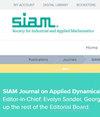使用拓扑数据分析量化不同的建模框架:斑马鱼模式的案例研究
IF 1.8
4区 数学
Q2 MATHEMATICS, APPLIED
引用次数: 0
摘要
应用动力系统学报,第22卷,第4期,第3233-3266页,2023年12月。摘要。数学模型在生物学应用中有多种形式。在复杂的空间动态和模式形成的情况下,随机模型也面临两个主要挑战:模式数据在很大程度上是定性的,模型实现可能会有很大差异。综上所述,这些问题使得很难将模型和经验数据联系起来,甚至是模型和模型之间的联系,从而限制了不同方法的结合,从而为生物学提供新的见解。这些挑战也提出了关于模型之间如何关联的数学问题,因为同样的问题有不同的解决方法。, Cellular Potts模型;离格、基于智能体的模型;点阵、元胞自动机模型;连续方法——以不同的方式处理不确定性和实现细胞行为。为了帮助打开这类问题的未来工作之门,在这里,我们采用拓扑数据分析和计算几何的方法,以公平、可比的方式定量地联系同一生物过程的两种不同模型。为了集中我们的工作并说明具体的挑战,我们将重点放在斑马鱼皮肤模式形成的例子上,并将基于主体和元胞自动机模型产生的模式联系起来。本文章由计算机程序翻译,如有差异,请以英文原文为准。
Quantifying Different Modeling Frameworks Using Topological Data Analysis: A Case Study with Zebrafish Patterns
SIAM Journal on Applied Dynamical Systems, Volume 22, Issue 4, Page 3233-3266, December 2023.
Abstract. Mathematical models come in many forms across biological applications. In the case of complex, spatial dynamics and pattern formation, stochastic models also face two main challenges: pattern data are largely qualitative, and model realizations may vary significantly. Together these issues make it difficult to relate models and empirical data—or even models and models—limiting how different approaches can be combined to offer new insights into biology. These challenges also raise mathematical questions about how models are related, since alternative approaches to the same problem—e.g., Cellular Potts models; off-lattice, agent-based models; on-lattice, cellular automaton models; and continuum approaches—treat uncertainty and implement cell behavior in different ways. To help open the door to future work on questions like these, here we adapt methods from topological data analysis and computational geometry to quantitatively relate two different models of the same biological process in a fair, comparable way. To center our work and illustrate concrete challenges, we focus on the example of zebrafish-skin pattern formation, and we relate patterns that arise from agent-based and cellular automaton models.
Abstract. Mathematical models come in many forms across biological applications. In the case of complex, spatial dynamics and pattern formation, stochastic models also face two main challenges: pattern data are largely qualitative, and model realizations may vary significantly. Together these issues make it difficult to relate models and empirical data—or even models and models—limiting how different approaches can be combined to offer new insights into biology. These challenges also raise mathematical questions about how models are related, since alternative approaches to the same problem—e.g., Cellular Potts models; off-lattice, agent-based models; on-lattice, cellular automaton models; and continuum approaches—treat uncertainty and implement cell behavior in different ways. To help open the door to future work on questions like these, here we adapt methods from topological data analysis and computational geometry to quantitatively relate two different models of the same biological process in a fair, comparable way. To center our work and illustrate concrete challenges, we focus on the example of zebrafish-skin pattern formation, and we relate patterns that arise from agent-based and cellular automaton models.
求助全文
通过发布文献求助,成功后即可免费获取论文全文。
去求助
来源期刊

SIAM Journal on Applied Dynamical Systems
物理-物理:数学物理
CiteScore
3.60
自引率
4.80%
发文量
74
审稿时长
6 months
期刊介绍:
SIAM Journal on Applied Dynamical Systems (SIADS) publishes research articles on the mathematical analysis and modeling of dynamical systems and its application to the physical, engineering, life, and social sciences. SIADS is published in electronic format only.
 求助内容:
求助内容: 应助结果提醒方式:
应助结果提醒方式:


